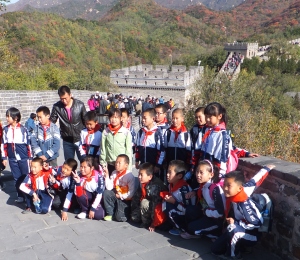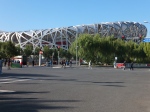As a child, I had always dreamed of going to China. It was that “Mysterious East” that I had read about in books that intrigued me. I had read “The Good Earth”, one of my Mom’s Book of the Month Club books. It was a novel written by Pearl S. Buck and published in 1931. It was the story of a farming village in China prior to WW1. I had also scanned the World Book of Knowledge that belonged to my Dad, for maps and pictures of that part of the world as well as Life Magazines. I loved the images of The Forbidden City, the Temple of Heaven, The Great Wall and streets full of people riding bicycles. I had read about the Manchurians and the Mongolians, the Han Chinese, the Ming and the Qing Dynasties. In school we studied Mao Zedong, who founded the People’s Republic of China in 1949 and his attempts to modernize China’s economy by focusing on agriculture and industry. Mao died in 1976.
I watched on TV as the Student Protests unfolded in Beijing’s Tiananmen Square, where on June 4, troops with assault rifles and tanks inflicted thousands of casualties on unarmed civilians trying to block the military’s advance on the square which had been occupied for 7 weeks. This event became known as the Tiananmen Square Massacre.
While attending Home Coming at the University of Alberta in the fall of 2011, I picked up a brochure from AHI Travel and noticed a tour, “China and the Yangtze for October 2012.” I was hooked! I booked the tour, obtained my visa, got my shots and exchanged my money.
October 17, 2013 saw me standing in Tiananmen Square on my first day in Beijing. And no, the bright Alberta like Sky is not Photo Shopped. It was a glorious morning, about 15C, and the clear sky was the result of a big rainstorm the day before which had cleared the air. The huge Flower Basket was left over from the Public Holiday, National Day on October 1 to commemorate the Founding.
Next day I was at the Great Wall. Those pictures that I had seen in Life Magazine so long ago, were now real. What an amazing sight. This section of the wall at Badaling was used by the Chinese to protect their land and had many guards to defend China’s capital Beijing. Made of stone and bricks from the hills, this portion of the Great Wall is 7.8 meters (26 ft) high and 5 meters (16 ft) wide. The day I visited hundreds of school children on field trips were scurrying up and down the steep steps.
 One of the things I most wanted to see on my trip were the Terra Cotta Warriors at Xian. This is a collection of terracotta sculptures depicting the armies of the first Emperor of China. It is a form of Funerary Art buried with the emperor in 210 BC. Its purpose was to protect the emperor in his afterlife. The burial site was discovered in 1974 by some local farmers. Pit one is truly an overwhelming site with 6000 figures representing the Emperor’s Army along with their horses. One of the advantages of this tour was an opportunity to visit sites not open to regular tours. We were able to visit the Shaanxi Provincial Institute of Archaeology to view artifacts not yet made available to the public.
One of the things I most wanted to see on my trip were the Terra Cotta Warriors at Xian. This is a collection of terracotta sculptures depicting the armies of the first Emperor of China. It is a form of Funerary Art buried with the emperor in 210 BC. Its purpose was to protect the emperor in his afterlife. The burial site was discovered in 1974 by some local farmers. Pit one is truly an overwhelming site with 6000 figures representing the Emperor’s Army along with their horses. One of the advantages of this tour was an opportunity to visit sites not open to regular tours. We were able to visit the Shaanxi Provincial Institute of Archaeology to view artifacts not yet made available to the public.
Our tour now headed south to Guilin in the Guangxi Zhuang Autonomous Region. It sits on the west bank of the Li River and the name means “forest of sweet Osmanthus” owing to the large number of fragrant Sweet Osmanthus trees located in the city. China has 55 minorities and many live in this area. The city has long been renowned for its unique scenery of Karst topography. If you have ever looked at Chinese Paintings and wondered about the “lumpy mountains” …..well they are for real as a tour down the Li River showed me. In geographic terms, Karst Topography is a landscape shaped by the dissolution of a layer or layers of soluble bedrock, usually carbonate rock such as limestone or dolomite. South China is a major Karst area in the world, and Guilin is a rare example in terms of its scale and uniqueness.
China is a land of contrasts. I really had no expectations for my visit, but I was not to be disappointed in any way. The street scenes fascinated me. Whether is was parents and grandparents giving the children a ride to school on scooters, the ladies selling flowers in the Street Market at Chengdong or the markets at the relocation village on the Yangtze River, every turn brought new images. Food stalls provided a never-ending source of delight. Some of the wiring outside of buildings made me question our wiring codes…..thank goodness we have them! Traffic was everywhere and each day thousands of new drivers take to the road. Cars big and expensive flooded the roads.
One of my favorite stops was at a farming village near Xian. We went there on a rainy Sunday and the first to greet us was a group of preschoolers. They must have been 3 or 4 years old and language was not a barrier to these kids. Our host at the village was an artist who has been sent to the countryside during Mao’s time as Chairman. During The Cultural Revolution, he had declared certain privileged urban youth would be sent to mountainous areas or farming villages in order to learn from the workers and farmers there.
We were entertained by a local group with a Dragon Boat Dance. Fernando and I were encourage to take our turn “paddling the boat”. Fernando was the oldest member of our tour group and his energy was amazing for a man well into his eighties.
Later in the day we were taken to Mr. Zhang’s Studio where he gave us a lesson in Chinese Brush Painting. Of course we could also purchase his Folk Art and most of us came away with several pieces all of mine featuring pandas.
I had seen the real thing when we visited the zoo at Chengdong. Er Shun was getting ready for her big move to Canada. She was going to spend 5 years each at the Toronto and Calgary Zoos. I am not sure how impressed Er Shun was with the prospect of this trip, as the behavior she displayed when she heard Canadian voices was very explicit. Judge for yourself in the pictures (right of Bottom). I hope she will be in a better frame of mind when she lives in Toronto. I will visit her again once she gets to Calgary in 2018!
We took a three-day Yangtze River Cruise, the highlight of which was the trip through the locks of the Three Gorges Dam. This dam which is 2 km across and 600 feet high, provides a significant amount of China’s energy.Building it and the 400 mile long reservoir, meant that there was flooding a of a very large area, causing destruction to a number of villages and cultural sites. Millions of people had to be relocated. We went through the locks at night and it took several hours….a fascinating experience. Next day we visited the museum which explains the complete story of the dam and its construction.
Beijing and Shanghai are fabulous cities. For me, Beijing seemed a little too sanitized, the result of the demolition and construction it did in preparation for the 2008 Summer Olympics. We visited the “Bird’s Nest”, the Olympic stadium and I was certainly impressed with its size. Overall the city was very clean and there was construction going on everywhere…….roads, sewers, buildings!
Shanghai was definitely my favorite city. It had such a vibrancy to it…whether it was in the morning with people doing exercises in the park or at night when all the lights came on.
For centuries it was an administrative, shipping and trading city. It grew in importance in the 19th century due to the European recognition of its Port location. It was opened to Foreign Trade following the British Victory over China in the First Opium War and the subsequent Treaty of Nanking in 1842 which allowed the establishment of the Shanghai International Settlement.
Today you can see its growth everywhere, yet there still remains remnants of the British, French and American influence. The Bund was at onetime the heart of Colonial Shanghai. Many of these buildings remain, but now serve other purposes. Next to London, Shanghai is my second favorite World City and I can’t wait to return!

























Awesome my friend … I am really enjoying all your writings and pictures … Especially these in China … As Bri has visited and seen so many of the same places . Thanks for sharing ALL of your Wanderings … Am printing them off to keep in my box if memories .
Love u 💚…Judy
LikeLike